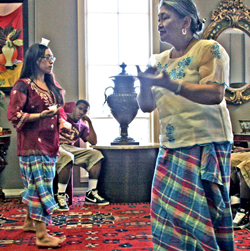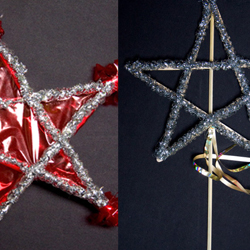Other Shreveport Articles
Cultural Preservation: Keeping the Flame Burning for Future Generations
Seasons and Cycles — Festivals and Rituals Mark Life's Rhythms
Of Hand and Heart: Handwork Connects Family and Community

The Filipino Community in the Ark-La-Tex Region: Coming Together for Culture and Community
By Laura Marcus Green
Originally, the Filipino Association of Northwest Louisiana, Fil-Am ARK-LA-TEX was founded in 1992 by the late Eden Sta. Ana, the wife of a doctor at Barkskale Air Force Base. As she began sharing Filipino cultural traditions like the bamboo pole dance tinikling with the broader community, she launched the new organization as the Filipino Association of Northwest Louisiana. Loreta Leavitt currently chairs the association. Under her leadership, the organization's name changed to reflect its expanded service to Filipino-Americans living in the tri-state area. Many Fil-Am ARK-LA-TEX members are affiliated with Barksdale Air Force Base, so their participation can be ephemeral, in keeping with military life. However, like Loreta, a number of the orgnization's core members are longstanding residents of the Shreveport-Bossier City area. Fil-Am ARK-LA-TEX meets monthly throughout the year to conduct ongoing business, hold dance and music rehearsals, and share traditional foods.
There are currently around 200 Filipino families living in the Shreveport-Bossier City area and this number is growing. Fil-Am ARK-LA-TEX's founding members are predominantly first-generation Filipino-Americans who emigrated directly to the U.S. from the Philippines for educational, economic, and professional opportunities. In part, participation in Fil-Am ARK-LA-TEX fulfills their need to stay connected to their home culture by sharing various traditions throughout the year. It also addresses their desire to pass on to their American-born children the things they treasure most about their culture. Loreta Leavitt reflects, "It's really comforting to promote and share our culture with the next generation. We try to extend it to the little ones."
Some second-generation youth began learning Filipino traditional dances as small children. Members of that younger generation are now college age and beyond, but they return to Shreveport to participate in Fil-Am ARK-LA-TEX activities. In 2003, Fil-Am ARK-LA-TEX established a scholarship fund that annually helps one graduating high school senior and one college freshman buy books for their classes. Students compete for the scholarship by writing an essay that addresses a question about Filipino cultural identity. Recipients must be active members of the organization and participants in the dance group. Fil-Am ARK-LA-TEX raises funds for the scholarship by selling traditional Filipino foods at various public functions. Members prepare and donate such dishes as egg rolls, fried rice, and shish kebab.

The Ark-La-Tex Filipino community is diverse, encompassing the Philippines' multicultural heritage. Fil-Am ARK-LA-TEX members relate that over 1,000 vernacular dialects are spoken in the Philippines. Tagalog [ta-GA-log] is the Filipino national language, however not everyone speaks that dialect. Through traditional dance, singing, cooking, and various seasonal celebrations, Fil-Am ARK-LA-TEX members explore a range of Filipino cultural expressions.
The Filipino calendar abounds with celebrations that bring communities together. Fil-Am ARK-LA-TEX members have woven some of their traditional holidays into Shreveport-Bossier City's annual cycle of activities. Each year, the group puts on several public programs and takes part in community-wide events, such as the ASEANA Spring Festival and the Red River Revel, among others. The annual ASEANA Festival is held every April in the Asian Gardens in downtown Shreveport. Sponsored by the ASEANA Foundation, the festival attracts thousands of participants to experience the area's Asian cultures through traditional music, dance, games, food, and crafts.
Each year, the festival highlights a particular culture. In 2011, Filipino culture was the focus. Fil-Am ARK-LA-TEX members transformed the downtown park into a Filipino town, complete with a plaza. There, they held a Pista Sa Nayon, which translates as, "all the town is celebrating" or "town festival," pista meaning "fiesta." The day-long event included Filipino cuisine, folk dances, traditional fiesta games, and a Santa Cruzan, or Holy Cross, procession. In alternate years, Fil-Am ARK-LA-TEX puts on either spring or autumn celebrations. Filipino Thanksgiving takes place in May, the season when people harvest their crops. Every other September, the organization hosts a luau to raise money for the Fil-Am ARK-LA-TEX scholarship. This ticketed event includes traditional food and dance.
Dance rehearsals and performances are a highlight of Fil-Am ARK-LA-TEX's activities. "We need to dance," group members explain. Every year, Fil-Am ARK-LA-TEX members add two to four dances to their repertoire, carefully choosing the dances to equitably represent the Philippines' diverse cultures. Deedee Sharbono has been the group's choreographer for several years. She also sews special outfits for each dance. Tapping 21st-century technology, the group seeks out performances of their selected dances on Youtube in order to learn the steps from high quality performers. Because of cultural differences among Filipino ethnic groups, a dance with the same name might have varied steps and costumes, depending on the region where it is performed. Group members feel a deep sense of fulfillment in learning and performing the dances. They find it especially rewarding to teach the dances to their children, ensuring the perpetuation of Filipino cultural traditions in Louisiana.
Traditional foods provide cultural sustenance through the sharing of dishes that evoke a sense of home and community. The Fil-Am ARK-LA-TEX annual general assembly meeting includes a potluck meal to which members bring traditional dishes from their home regions. Eric Roque, originally from Biñan, Laguna, Philippines, is known among the group as a traditional cook. One of his specialties include a stew made from pork and chicken cooked with soy sauce, bay leaves, vinegar, and garlic. Another is sinigang, a stew of pork or fish cooked in tamarind sauce with radishes, eggplant, spinach, and okra. Lechón, or roast pig cooked on a spit, is a well-known Filipino delicacy that Fil-Am ARK-LA-TEX members prepare on occasion. In Shreveport, Filipinos can buy special cooking ingredients at Bao Bao, an Asian store that carries Vietnamese and Filipino foods. The shop owners are willing to order special items from Houston upon request. In Houston, an international port, people can find any foods they might desire, as well as a Filipino restaurant.
Among the most important holidays in the Filipino calendar is Christmas. Fil-Am ARK-LA-TEX members reminisce about the beauty of Christmas time in their home country, which shines with many holiday traditions. The Filipino Christmas season begins on December 16th with Simbang Gabi, when people attend a 4:00 am mass on the nine mornings preceding Christmas Day, culminating in a Misa de Gallo, or Rooster's Mass, on the morning of December 24th. Three Kings (the Epiphany) marks the end of the Christmas season. During the holidays, people visit each other's homes, eat special foods, and enjoy radiant decorations, including parol—colorful Christmas lanterns symbolizing the Star of Bethlehem. Like many aspects of Filipino culture, parol vary from region to region. Pampanga in Northern Luzon hosts a large parol festival and competition each year. In the Philippines, parol are made with bamboo frames covered with paper or other materials. Capiz parol are made with translucent capiz shells that are either left their natural ivory hue or colorfully dyed for a more vibrant effect. Away from home, people use whatever materials are at hand. A recent Fil-Am ARK-LA-TEX Christmas party featured miniature parol made from popsicle sticks covered with red cellophane paper and lit from within, as well as silver pipe cleaner parol made for table decorations.

During the winter holidays, the Fil-Am ARK-LA-TEX choir performs carols in people's homes, replicating the tradition that is so important to the Filipino Christmas season. Echoing the theme of Filipino multiculturalism, the choir chooses songs that reflect different ethnic and language groups. The multigenerational choir begins rehearsing in October. Come Thanksgiving, they perform every weekend through the holiday season.
In the Philippines, it is customary for people to go caroling house to house. People improvise with all manner of instruments, including homemade tambourines made from bottle caps. In the Shreveport-Bossier City area, Filipino caroling is more formal. The group is invited to private homes, where they are hosted by individual community members. The choir includes several guitar players. Some of the host homes have pianos that the carolers can use for accompaniment. Loreta Leavitt relates that the caroling tradition is very emotional for choir members who grew up in the Philippines, as it reminds them of home. The carolers receive food and donations, which they give to a charity or cause designated by the group.
If Filipino cultural identity is diverse, there are some things that unify the group—literally. Loreta Leavitt explains the concept of Bayanihan [ba-ya-NEE-han], a Tagalog word that means "people coming together, everyone coming together to help out." The term has its roots in the word bayan, referring to a nation, country, town or community. The whole term bayanihan implies a spirit of communal unity or effort to achieve a particular objective. The concept of bayanihan originates in a common tradition in Filipino towns, in which community members come together to help a family move its house to a new location. Stilt houses are lifted from the ground on bamboo frames that are carried by men who work as a team to transport the house from one location to another. Bayanihan is akin to the American barn raising tradition. As in a barn raising, an actual bayanihan culminates in a fiesta given by the host family to thank the volunteers who helped move their home. Currently the term Bayanihan is used in many contexts to invoke the spirit of cooperative effort. Filipino arts, service, and philanthropic organizations across the globe incorporate the word into their names, maintaining bayanihan as an enduring part of the culture, at home and in diaspora.1
Loreta Leavitt observes that the idea of bayanihan resonates strongly with the older Filipinos in the community, who grew up with these values. Applying bayanihan to Fil-Am ARK-LA-TEX, she reflects, "You share, you extend, and you don't expect anything back. You never forget your culture." Through modeling bayanihan in the context of their cultural traditions and civic work, first generation Filipinos hope to instill their youth with this cooperative ethic. Fil-Am ARK-LA-TEX's full schedule of activities gives them ample opportunity to do so.
Notes
1. Extracted from a Wikipedia article on Bayanihan-http://en.wikipedia.org/wiki/Bayanihan.


